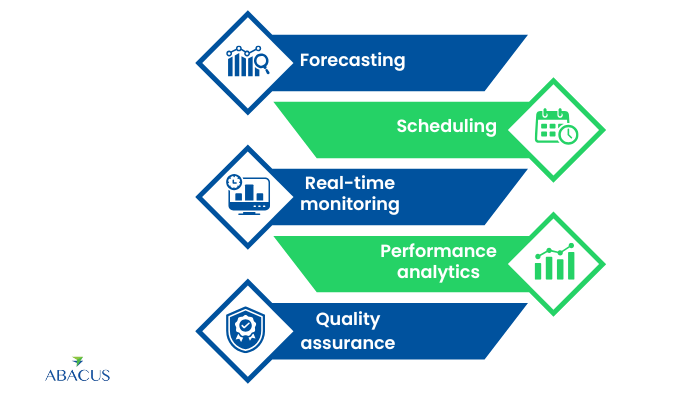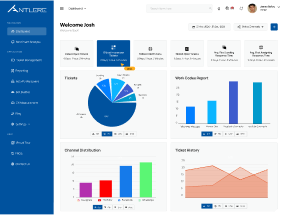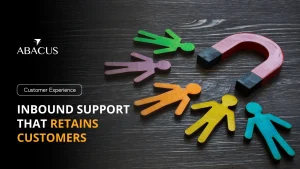Having the proper people on board, focused on critical business goals, and working productively is the cornerstone for success in every business unit. Therefore, contact centers need to deliver an exceptional customer experience which relies heavily on effective workforce management (WFM).
Workforce management helps to place the agents at the right place, at the right time and equip them with the right tools they need for support to enhance the overall customer experience. The article will cover the needs and aspects of contact center workforce management, how it can enhance customer satisfaction and deliver the best service.
What is Contact Center Workforce Management?
The process of forecasting, scheduling, monitoring and optimizing the performance of the call center agents is contact center workforce management (WFM). The main components of WFM are as follows;

- Forecasting: This is used to predict the rise in customer demand and know the call volumes.
- Scheduling: It is to place the right number of agents at the right time for the best outcome.
- Real-time monitoring: This is to track the agent’s performance and to reduce the overall customer wait time.
- Performance analytics: There are certain metrics, including customer satisfaction (CSAT), first call resolution (FCR) and Average handle time (AHT), which help determine the performance.
- Quality assurance: This is to know that the customer interactions meet the standards of the company.
By coping with these elements effectively, businesses can create an environment where customer inquiries can be handled effectively.
The Link Between Workforce Management and Customer Satisfaction
There is a direct link between the contact center workforce management and customer satisfaction as the better the workforce is managed, it will in turn boost the customer satisfaction:
Reduced wait times:
The biggest issue is if the customers are left waiting for a long time and this needs to be resolved as quickly as possible. This is important for maintaining positive customer experience.
Improved First Call Resolution:
By placing skilled agents and the right agents at the right time, we are most likely to fix customer issues in the first call, reducing overall frustration.
Key Strategies for Effective Contact Center Workforce Management
To have maximum customer satisfaction, contact centers should adopt the below stated strategies;
1. Accurate Forecasting
Accurate forecasting is the base of the workforce management. But it does mean we forecast the volume of customer interactions with historical data, trends and seasonality. For example, a retail organization may predict how many agents it will need when there will be a lot of customer inquiries during a holiday season.
Workforce management’s core is forecasting.
Example:
AI driven forecasting tools are used by a global e-commerce company to predict that there will be an increased number of inquiries by the end of the customer during Black Friday. When they forecast this, they adjust their staffing levels to be ready for the spike of calls and calls are handled quickly by customers.
2. Dynamic Scheduling
The idea behind scheduling is simply how to guarantee that the number of agents is balanced against the number of incoming requests at a given point in time. Scheduling is effective, taking into account peaks and valleys in the volume of the calls, by equalizing workloads between employees so as to reduce their burnout.
Example:
Cloud based scheduling software applies in telecommunications companies which dynamically adjust agent shifts in real time. In case of a technical outage, there is an unexpected spike in inbound calls, the system automatically reassigns agents from other departments to help answer the demand.
3. Real time monitoring and adjustment
The managers are able to see the real time monitoring of the ongoing performance, making necessary adjustments even when the project is running. Contact centers can be monitored using key metrics to see if a contact center is underperforming (such as wait times, handling times, service levels).
Example:
There is a contact center for financial services that uses real-time dashboards to track agent performance and the number of customers waiting. Occasionally, there is a huge increase in calls, and the supervisor can immediately add more agents to high demand queues to reduce customer wait time and subsequent dissatisfaction.
4. Agent Training and Development
Customers expect a positive experience – and you need well-trained agents to deliver that. Agents are continuously trained in product knowledge, communication skills, and problem-solving abilities so that they can serve customers with basic to difficult enquiries.
Example:
Every software company runs training sessions for its agents to be updated on new features and to troubleshoot the most common technical issues that the agents face. By doing so, agents are better equipped to respond quickly and accurately to customer questions, achieving higher resolution times and a happier customer.
Workforce Management Made Easy with Tools & Technologies
This is where AI, automation and cloud-based solutions are introducing new features into the landscape of workforce management. Using these tools companies are able to optimize their staffing, improve their performance and deliver a seamless customer experience.

AI-powered forecasting: With a greater level of accuracy, AI and machine learning can forecast call volumes, so contact centers can be ready for call volume surges.
Cloud-based scheduling software: With these platforms, contact centers can handle remote teams and take real time schedule changes as required.
Performance analytics tools: Such methods provide statistics to measure agent performance, allowing managers to compare agents’ performance and identify areas where improvements can be made, as well as reward good performing agents.
Measuring Success: Those are called Key Performance Indicators (KPIs).
To assess the effectiveness of workforce management and its impact on customer satisfaction, contact centers track various KPIs:
- Average Handle Time (AHT): A time required to resolve a customer inquiry. Then, if you have a lower AHT, that means that your agents are already well trained to resolve those types of issues quite quickly.
- First Call Resolution (FCR): The number of issues spotted and fixed with a first interaction. High FCR is an indication of how efficient the agent in satisfying customers is.
- Customer Satisfaction (CSAT) Scores: It directly measures how happy customers are with the service provided. Post interaction CSAT surveys enable us with the feedback we need to improve workforce management.
This way of reviewing these KPI’s enables the business to fine tune their workforce management strategies to increase the momentum of customer satisfaction with continued improvements.
Workforce management common problems and how to address them
While contact center workforce management can significantly enhance customer satisfaction, contact centers face common challenges:

Unpredictable call volumes: It’s hard to predict customer demand fluctuations. AI backed forecasting tools and historical data analysis can be a good way to minimize the effect of these variations.
Agent turnover and burnout: With high turnover comes service quality gaps. Besides offering training and career development opportunities, incentives can also lower burnout and increase retention as well.
Scheduling inefficiencies: Scheduling is hard, and mistakes are easily made if you don’t have the right tools. With dynamic scheduling systems based on cloud, we can bring on more efficiency and agent happiness.
Conclusion
In an effective contact center workforce management, boosting customer satisfaction is critical. Forecast demand, schedule efficiently, monitor performance in real time, & continue training to know your business will meet the customer’s expectations, every time. Contact centers can provide wonderful service and build long-term customer loyalty, with the right WFM tools and solutions.
Abacus Outsourcing workforce management service helps you convert your contact center into a more powerful customer satisfaction engine, leading to both better customer experiences overall and operational success.
Unlock better customer experiences and drive operational success with Abacus Outsourcing’s workforce management solution.










